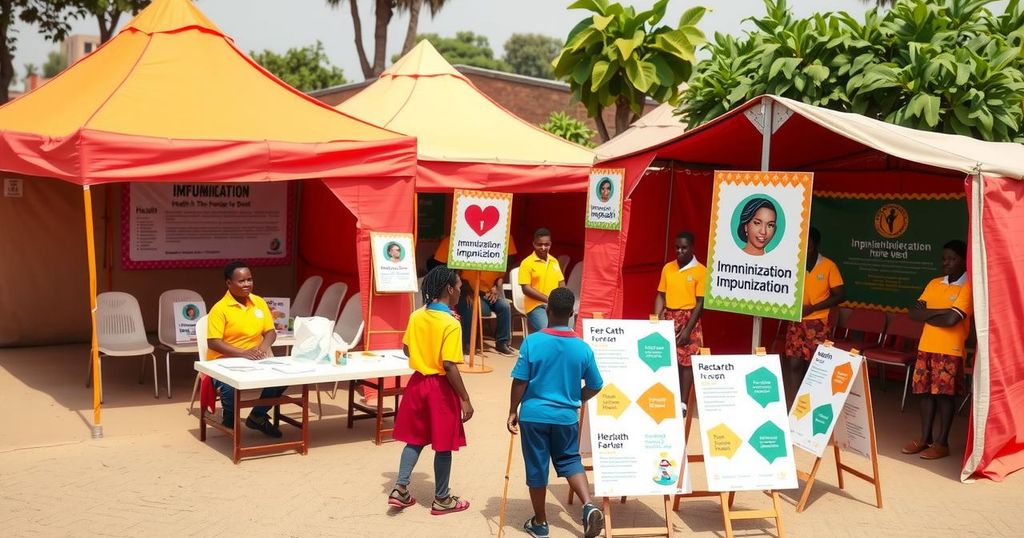Nigeria aims to combat poliovirus transmission through the Targeted Local Outbreak Response strategy, addressing issues of vaccine hesitancy and logistical challenges. A recent campaign reached over 3.6 million children, but gaps remain. Plans for further immunization efforts are underway, highlighting the commitment to protect every child from poliovirus and achieve a polio-free status.
In Maiduguri, Jere Local Government Area, Nigeria, a four-year-old girl named Amina has received inconsistent vaccinations since birth, exposing her to poliovirus. Her mother explained that Amina missed doses because they were often unavailable during vaccination campaigns. This situation highlights Nigeria’s struggle to eliminate poliovirus, particularly in remote and conflict-affected regions.
Addressing the transmission of circulating variant poliovirus type 2 (cVPV2) is crucial for Nigeria’s health agenda. Despite substantial vaccination efforts targeting children under five, 122 confirmed cVPV2 cases were reported from January 2024 to March 10, 2025, including 10 cases in 2025 alone. The National Primary Healthcare Development Agency (NPHCDA) has implemented the Targeted Local Outbreak Response (TLR) strategy in collaboration with the World Health Organization (WHO) to close immunity gaps and prevent virus spread.
Recent vaccination campaigns reached 3.8 million children in high-burden states like Borno and Kano, with over 3.6 million receiving the novel oral polio vaccine type 2 (nOPV2). However, some children remained unvaccinated due to noncompliance or absence during campaigns. Dr. Abdulkadir Usman Gana, the NEOC Incident Manager, emphasized the need for enhanced community mobilization to ensure all children are vaccinated to combat cVPV2.
The NEOC operations group, overseen by WHO, utilizes data to design TLR campaigns effectively. This process involves analyzing various factors, such as recent cVPV2 cases and population immunity levels, to tailor responses appropriately. Dr. Walter Kazadi Mulombo, WHO Country Representative in Nigeria, commended the TLR strategy for its focused approach that offers the opportunity to effectively halt poliovirus transmission.
WHO’s support was vital in executing the campaign, training over 18,727 health workers and maintaining comprehensive coordination. Dr. Yusuf Muhammad Argungu, WHO State Coordinator for Sokoto State, noted the coordination and logistical efforts that facilitated successful vaccination. Field volunteer Zayyanu Adamu illustrated community involvement by organizing dialogues to educate residents about the vaccine and addressing noncompliance through collaboration with local leaders.
To assess the effectiveness of vaccination efforts, Lot Quality Assurance Surveys (LQAS) were conducted, yielding positive results—97% of surveyed local government areas achieved over 90% vaccination coverage. This indicates a strong performance in the recent vaccination campaign.
Looking ahead, Nigeria plans the next phase of the TLR starting on March 12, 2025, targeting 946,600 children across five states. Collaborative efforts involving NPHCDA, NEOC, WHO, and local communities demonstrate Nigeria’s commitment to ensuring that all children are protected from poliovirus. With steadfast resolve and continued global support, Nigeria aspires toward a future free of polio.
In conclusion, Nigeria’s ongoing battle against poliovirus showcases the critical need for effective strategies and community engagement. The Targeted Local Outbreak Response was instrumental in reaching millions of children, despite challenges such as noncompliance and logistical issues. The country remains focused on closing immunity gaps through collaborative efforts, ensuring every child is vaccinated and contributing to the goal of eradicating poliovirus entirely. Continued innovation, community trust, and support from global health partners will be vital in achieving a polio-free future.
Original Source: www.afro.who.int




